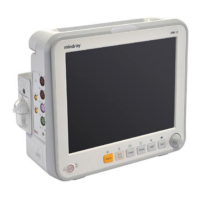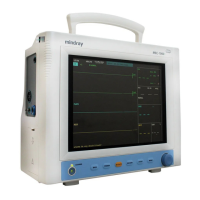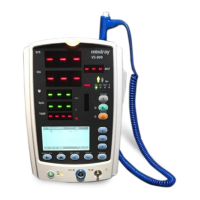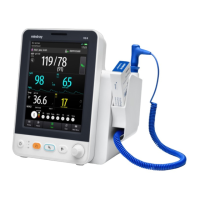7-8
Setting the Alarm Level
1. Select the parameter window for your desired measurement to enter its setup menu.
2. Select [Alm Lev] and toggle between [High], [Med] and [Low].
You can also set alarm levels for all alarms together:
1. In the main menu, select [Alarm Setup >>]→[Alarm Levels Setup >>].
2. You can view and set alarm levels for all the ongoing measurements in the popup
menu.
Adjusting Alarm Limits
To adjust alarm limits for individual measurements,
1. Select the parameter window for your desired measurement to enter its setup menu.
2. In the setup menu, select the alarm limit you want to change and then select the
appropriate setting.
WARNING
z Make sure that the alarm limits settings are appropriate for your patient before
monitoring.
z Setting alarm limits to extreme values may cause the alarm system to become
ineffective. For example, High oxygen levels may predispose a premature infant to
retrolental fibroplasia. If this is a consideration do NOT set the high alarm limit to
100%, which is equivalent to switching the alarm off.
Recording Alarms Automatically
When a measurement alarm occurs, automatic recording of all the measurement numerics
and related waveforms is possible when the measurement’s [Alarm] and [Alm Rec] are set
on.
To enable or disable automatic start of alarm recordings for individual measurements, you
can select [Alm Rec] and toggle between [On] and [Off] in the setup menu for your desired
measurement.
Additionally, you can change the length of the recorded waveforms. In the [Alarm Setup]
menu, select [Recording Length] and toggle between [8 s], [16 s] and [32 s]:
[8 s]: 4 seconds respectively before and after the alarm trigger moment.
[16 s]: 8 seconds respectively before and after the alarm trigger moment.
[32 s]: 16 seconds respectively before and after the alarm trigger moment.

